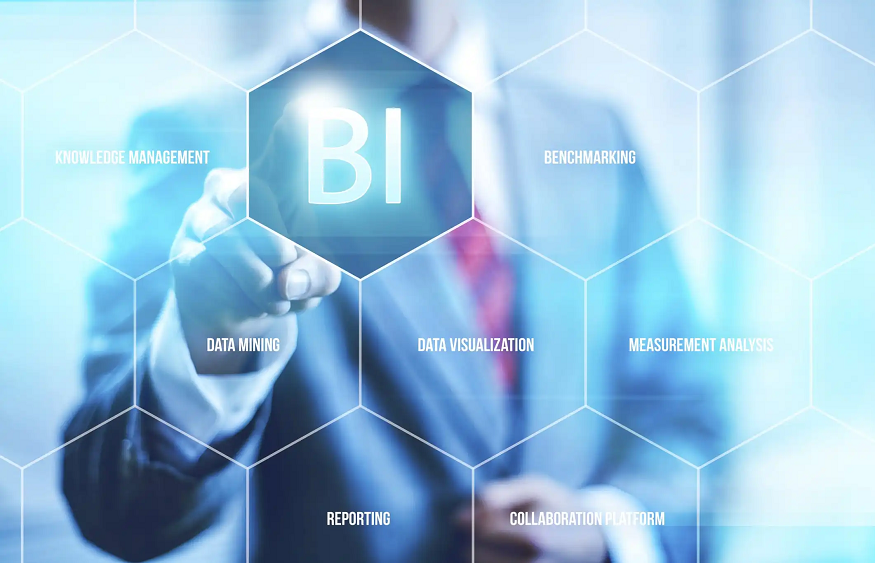BI (business intelligence) reporting, analyzing, and portraying the business metrics – has become quite fundamental for every business out there. However if you want to perform each of the tasks we have mentioned before, you have to use some tools too.
But, what do we mean when we say business intelligence reporting tools?
Which ones should you use?
How do you need to utilize them?
In this article, we have talked about each and everything in an elaborate manner. So, without any further ado, let’s get started with the blog right away.
How Does Business Intelligence Work?
A: The Definition
Business intelligence (BI) is a process that involves gathering, analyzing, and transforming raw data into meaningful and actionable insights for businesses. It helps organizations make informed decisions by providing them with a comprehensive understanding of their operations, market trends, customer behavior, and other critical factors.
B: How It Works
At its core, business intelligence revolves around the idea of collecting data from various sources within and outside an organization. These sources can include transactional databases, customer relationship management (CRM) systems, social media platforms, external market data, and more. The data can be structured (e.g., numbers, dates) or unstructured (e.g., text, images).
Once the data is gathered, the next step is to transform it into a consistent and usable format. This involves cleaning and organizing the data to remove errors, duplicates, or any other inconsistencies. The data is then stored in a centralized data warehouse or a data mart, which acts as a repository for all the information.
After the data is organized, it’s time to analyze it. Business intelligence tools and techniques come into play here. These tools can range from simple spreadsheets to sophisticated data visualization software and predictive analytics algorithms.
They can also help in examining the data from different angles, identifying patterns, trends, and correlations that might be hidden within the vast amounts of information.
C: The Role of Data Visualization
Data visualization plays a vital role in business intelligence.
By presenting data in visually appealing charts, graphs, and dashboards, it becomes easier for decision-makers to grasp complex information quickly. Visualizations can include sales reports, customer segmentation, market share comparisons, and more.
D: Some Additional Information Related to Business Intelligence
Business intelligence also involves the use of advanced analytics techniques such as data mining, machine learning, and predictive modeling.
These methods go beyond simple data analysis and aim to discover deeper insights, forecast future outcomes, and identify potential opportunities or risks.
For example, a retailer might use historical sales data and machine learning algorithms to predict future demand for certain products.
Moreover, business intelligence is not just about looking backward or predicting the future.
It also involves monitoring real-time data through tools like business activity monitoring (BAM) or key performance indicators (KPIs).
This allows businesses to track their performance against predefined targets or benchmarks and take corrective actions promptly.
What is the Aim of Business Intelligence Reporting?
The aim of Business Intelligence (BI) reporting is to provide actionable insights and data-driven information to support decision-making processes within an organization.
BI reporting involves collecting, analyzing, and presenting data in a way that is meaningful and useful for business users, such as executives, managers, and analysts.
Keep reading to know more about it –
1: Data analysis and interpretation
BI reporting aims to analyze large volumes of data from various sources to identify patterns, trends, and correlations. By examining historical and current data, organizations can gain a deeper understanding of their business operations and performance.
2: Performance Measurement and Monitoring
BI reporting enables organizations to track key performance indicators (KPIs) and other metrics relevant to their business objectives.
By visualizing data in charts, graphs, and dashboards, decision-makers can assess performance, identify areas for improvement, and monitor progress towards goals.
3: Decision Support
BI reporting provides decision-makers with timely and accurate information to make informed decisions. By presenting data in a clear and intuitive manner, BI reports help executives and managers evaluate different scenarios, identify opportunities, and mitigate risks.
4: Operational Efficiency
BI reporting aims to optimize operational processes by identifying inefficiencies, bottlenecks, and areas of improvement. It enables organizations to monitor resource utilization, identify cost-saving opportunities, and streamline operations for enhanced productivity.
5: Forecasting and Predictive Analysis
BI reporting can leverage historical data and advanced analytics techniques to generate forecasts and predictive models.
By analyzing past trends and patterns, organizations can make informed predictions about future outcomes, helping them anticipate market changes and make proactive decisions.
Bonus: Data Democratization
BI reporting aims to make data accessible and understandable to a wider audience within an organization. By offering self-service reporting tools and interactive visualizations, it empowers users to explore and interpret data independently, reducing dependence on IT or data analysts.
Do You Really Need Business Reporting Tools?
Absolutely! Business reporting tools play a crucial role in helping organizations make informed decisions and gain valuable insights from their data. Here are some reasons why you really need business reporting tools:
1: Data Visualization
Reporting tools provide visual representations of data through charts, graphs, and dashboards. This makes it easier for business users to understand complex information at a glance and identify trends or patterns.
2: Data Consolidation
Reporting tools allow you to gather data from various sources, such as databases, spreadsheets, and cloud applications, and consolidate it into a single, centralized location. This saves time and effort, as you don’t have to manually gather and analyze data from different sources.
3: Real-time Reporting
Many reporting tools offer real-time or near real-time reporting capabilities. This means you can access up-to-date information and monitor key metrics in real time, enabling you to respond quickly to changes or trends in your business.
4: Customizable Reports
Business reporting tools typically offer flexibility in creating custom reports tailored to your specific needs. You can choose the data elements, metrics, and visualizations you want to include in your reports, allowing you to focus on the most relevant information for your decision-making process.
5: Performance Tracking
Reporting tools help you track the performance of your business by measuring key performance indicators (KPIs) and metrics. This allows you to assess the effectiveness of your strategies, identify areas for improvement, and make data-driven decisions to drive business growth.
6: Data Accuracy and Consistency
Manual reporting processes are prone to errors and inconsistencies. With reporting tools, you can automate data collection, aggregation, and analysis, reducing the risk of human error and ensuring the accuracy and consistency of your reports.
7: Collaboration and Sharing
Reporting tools often come with collaboration features that allow multiple users to work on reports simultaneously. You can share reports with team members, stakeholders, or clients, enabling effective collaboration, better communication, and alignment across the organization.
8: Compliance and Governance
For regulated industries or organizations with data privacy concerns, reporting tools can provide built-in security measures and compliance features. They help ensure data integrity, protect sensitive information, and maintain regulatory compliance.
9: Forecasting and Predictive Analytics
Advanced reporting tools may offer forecasting and predictive analytics capabilities. By analyzing historical data and trends, these tools can help you predict future outcomes, anticipate market changes, and make proactive business decisions.
10: Cost and Time Savings
Implementing reporting tools can lead to significant cost and time savings. Automation reduces the manual effort required for data analysis and report generation, freeing up resources to focus on value-added activities and strategic initiatives.
Top 5 Business Reporting Tools That You Should Use
There are several excellent business reporting tools available in the market that can help you streamline your data analysis and reporting processes. Here are the top five business reporting tools that you should consider using:
1: Power BI
Power BI is a powerful business intelligence tool developed by Microsoft. It allows you to connect to various data sources, transform and clean the data, and create interactive visualizations and reports. Power BI offers a user-friendly interface, robust data modeling capabilities, and seamless integration with other Microsoft products.
2: Tableau
Tableau is a widely used data visualization and reporting tool that enables businesses to explore and understand their data. It provides an intuitive drag-and-drop interface for creating interactive dashboards, charts, and graphs. Tableau offers robust analytics capabilities and supports a wide range of data sources.
3: Google Data Studio
Google Data Studio (GDS) is a cloud-based reporting tool that allows you to create customizable and interactive reports and dashboards.
It integrates seamlessly with other Google products like Google Analytics, Google Sheets, and Google Ads, making it easy to access and analyze your data. Google Data Studio also supports collaboration, allowing multiple users to work on reports simultaneously.
4: QlikView
QlikView is a business intelligence and data visualization tool that provides powerful data analysis capabilities. It offers a unique associative data model, which allows users to explore data relationships in real time. QlikView supports interactive dashboards, ad hoc reporting, and data discovery, empowering users to make data-driven decisions.
5: Zoho Analytics
Zoho Analytics is a comprehensive reporting and analytics platform that caters to businesses of all sizes. It offers a wide range of reporting options, including tabular reports, charts, and dashboards. Zoho Analytics allows you to blend data from multiple sources, perform advanced calculations, and automate report generation.
Conclusion
So, that will be all for this article. If there’s something else you want to know about the same, we would ask you to comment below. We will try to help you out in any way we can!




